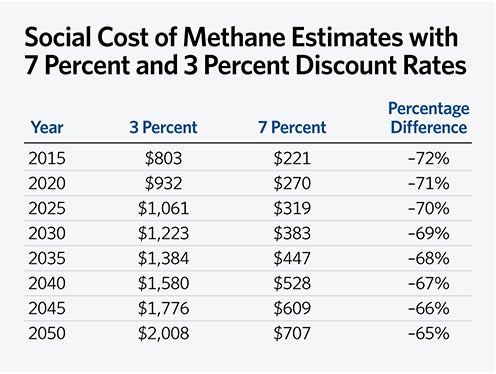Another Useless EPA Regulation That’ll Cost Americans More Money
David Kreutzer / Kevin Dayaratna /
Last August, while Congress was out of session and most people were on vacation, the Environmental Protection Agency issued a proposal for a new rule that would drive up the cost of natural gas and hobble one of the great modern energy success stories. The rule assigns a non-market cost to methane emissions (the social cost of methane) that is about 9 times the actual price at the pipeline.
The implication of these results is that the EPA would support regulations that would require the expenditure of up to $1,100 per ton to prevent the emission of each ton of methane in 2020, with higher values in subsequent years. Perhaps it would make sense if the numbers were related to reality.
To reach their conclusion, the EPA uses the same integrated assessment models that have failed spectacularly to accurately measure the social cost of carbon (SCC). Adding to the silliness is the additional uncertainty concerning the relative warming potential of methane versus CO2.
Recapping the problems with the integrated assessment models from our social cost of carbon analysis:
- The part of the models relating temperature to CO2 increases is out of date and significantly overstates the impact compared to recent best estimates.
- The EPA underestimates the discount rate (ignoring Office of Management and Budget guidance), which makes an order of magnitude of difference in the modeling results.
- The models do not fully represent the complexity of the real world and use arbitrary values for critical factors.
Regarding the last point, probably the harshest criticism of integrated assessment models comes from MIT professor Robert Pindyck, who wrote:
These models have crucial flaws that make them close to useless as tools for policy analysis: certain inputs (e.g. the discount rate) are arbitrary, but have huge effects on the SCC estimates the models produce; the models’ descriptions of the impact of climate change are completely ad hoc, with no theoretical or empirical foundation; and the models can tell us nothing about the most important driver of the SCC, the possibility of a catastrophic climate outcome. IAM-based analyses of climate policy create a perception of knowledge and precision, but that perception is illusory and misleading.
Our previous analysis of two of the integrated assessment models used by the EPA found that using the more realistic Office of Management and Budget stipulated discount rate (omitted by the EPA) caused estimates of the social cost of carbon to drop by more than 80 percent in one model and to actually go negative in the other.
Note: A negative social cost of carbon implies that there is actually an overall benefit from larger CO2 emissions, not a cost. That conclusion, of course, undermines the whole climate change enterprise, which likely accounts for the EPA’s decision to omit the data.
Our preliminary investigation of the social cost of methane (SCM) reveals impacts and flaws of the same sort as in the social cost of carbon analysis.
Economists at the EPA kindly provided us with the code they used to modify the DICE Model for use in estimating the social cost of methane in an article they published in Climate Policy. The results of their modeling were incorporated in the proposed EPA rule.
Our analysis has focused on measuring the impact of changes in the discount rate in the DICE Model. As was done previously in generating a value for the social cost of carbon, the EPA ignored Office of Management and Budget guidance to include a 7.0-percent discount rate in their calculations.
The EPA estimates the social cost of methane using 2.5-percent, 3.0-percent, and 5.0-percent discount rates. The lower the rate, the higher the estimate of potential benefits from regulation.
Conspicuous by their absence are estimates using the 7.0-percent discount rate that reflects the real return on capital in the U.S. stock market over the past two centuries. The EPA uses the social cost of methane values generated with the 3.0-percent discount to calculate the cost/benefits in its regulatory impact analysis for the rule.
Use of the proper discount rate would drop the estimated social cost of methane by about 70 percent, a cost that would justify far less intrusive regulation than the EPA desires.
Using a 7.0-percent discount rate drops the estimated benefits of reducing methane emissions from hundreds of millions of dollars per year to tens of millions of dollars per year.
With these lower estimated benefits, the net impact of the rule is revealed to be a needless cost to American society of nearly $100 million per year in 2020 and over $150 million per year in 2025.
The chart accompanying this article was updated on Nov. 3, 2016.

